This post has been updated to reflect the discontinued use of Tradescantia’s former common name, ‘Wandering Jew’, with its racial beginnings, to its new common names of ‘Wandering Dude’, ‘Inch Plant’ & ‘Wandering Spiderwort’.

The Tradescantia is the perfect houseplant.
Yeah, I know, I know. That’s a big claim to make, but hear me out.
- They practically propagate themselves.
- They are incredibly easy to care for.
- They are the very definition of hardy.
- If you do manage to kill one, all you need is one little leaf node to get it going again.
- They have brilliant, showy foliage.
- You can keep them compact in a pot,
- Or grow them as a hanging plant with long, sweeping tendrils.
- And you can find them easily everywhere.
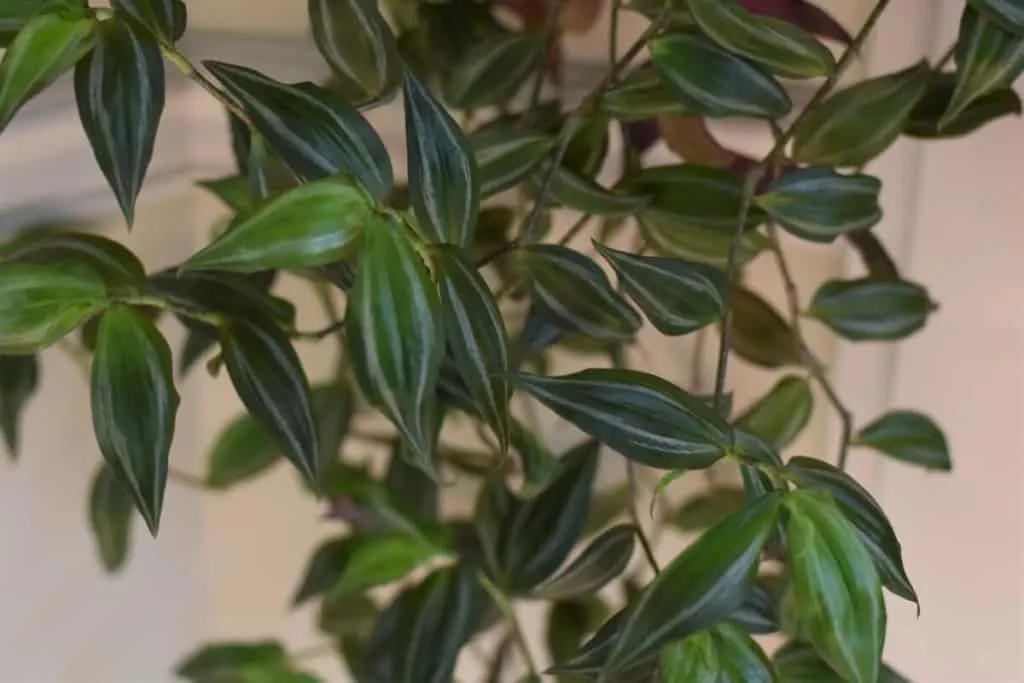
What’s In a Name?
For a long time, the plant’s common name was Wandering Jew. Most assumed its origins to be biblical, referring to the story of the Israelites wandering the desert. However, it’s now believed to come from a fictional character – a person who taunted Jesus on his walk to Golgotha, cursed to wander the land until Jesus’ second coming.
This character has been used to promote antisemitism for centuries. (Thought to come from the 13th century and used most recently in Nazi propaganda in WWII.)
Like so many botanical names, we are only now beginning to look at their true origins. Most were named not by the native peoples where the plants were found but by the colonials who claimed their “discovery.” The resultant taxonomy often being laced with racial slurs.
The name Wandering Jew has been rightfully shelved and is now commonly known as Inch Plant, Wandering Spiderwort, or the jovial Wandering Dude – kind of like that happy-go-lucky friend that couch surfs.
These common names describe three types of plants from the Tradescantia species: zebrina, pallida, and fluminensis.
Native to Central and South America
While these three all started in Central and South America, they have lived up to their names.
These guys grow all over the world, and in some places, they are considered an invasive species. Their invasiveness is the key to what makes them a great houseplant.
They just keep going!
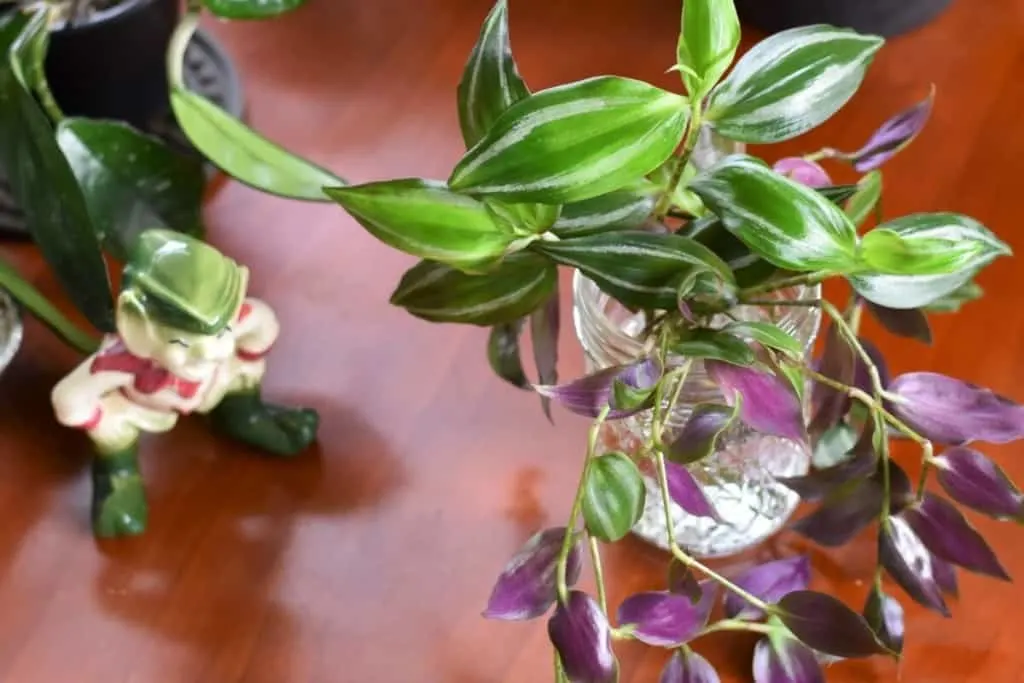
The Tradescantia zebrina is known for its deep green leaves slashed with silver streaks, hence the zebra in its name.
These are my favorite of the three, as it’s the most striking. I love how the silver stripes almost seem to sparkle, and the deep maroon of the other side of their leaves peeps through all the green.
Even when they aren’t flowering, this plant is gorgeous.
Tradescantia fluminensis has dark green leaves, and pure white flowers made up of three petals. Their shape reminds one of a trinity Celtic knot. Simple and beautiful. I love the stark contrast between green and white.
This particular species of Tradescantia is highly invasive and is considered more of a pest than a sought-after houseplant. With that in mind, it’s still a beautiful addition to your collection of houseplants.
Recently, I was introduced to the Tradescantia pallida. I found this gorgeous deep purple plant with pale flowers creeping across the mulch in front of a restaurant. I snagged a small leader and brought it home, where I was surprised to learn it was a type of Inch Plant.
It’s also known as Purple Heart, and it’s not hard to see why. Its purple leaves and stems are a nice change from the typical green of most houseplants.
Light
Wandering Dude loves bright indirect sunlight. Put this stunner in your east-facing window, and it will flourish. Turn your pot every few weeks to encourage even development.
If it’s not getting enough light, the silvery streaks will fade. This is a good indicator of whether your plant is getting enough light. If you want to encourage blooming, the more light it gets, the better.
Soil
Like most easy to care for houseplants, a simple potting mix is enough to keep them happy. They prefer to stay moist, but not soggy, so having a soil mixture that drains well is essential. I add a bit of perlite and sand to my mix when repotting my Inch Plant.
When you are repotting a well-established plant, it’s okay to go with a bigger than normal pot. You can easily replant it in a container up to 3” larger than its current pot, and your plant will happily settle in without too much fuss.
Fertilizer
This houseplant doesn’t necessarily require regular feeding for it to look great. However, if you wish, you can use a water-soluble fertilizer every month or so. Be sure to dilute it, so you don’t burn your plant’s roots.
Watering
Keep your plant happy by watering it whenever the soil is dry to ½”. You don’t ever want the plant to dry out completely.
Inch plants love a humid environment, so spray them often, and they will thank you by flourishing.
Growth
Because of their aggressive growth habits, you should pinch your Inch Plant back to keep it in check; this is especially important if you are growing it in a pot rather than as a hanging plant.
You can pinch it back hard, and it will bounce back. Always use a clean pair of scissors that you’ve rubbed with alcohol to prevent infection.
Occasionally, I have let mine get long and somewhat disheveled looking, but these plants are inherently forgiving.
If it gets too leggy, just pinch it back hard and repot it. You’ll have a beautiful looking plant again in about a month.
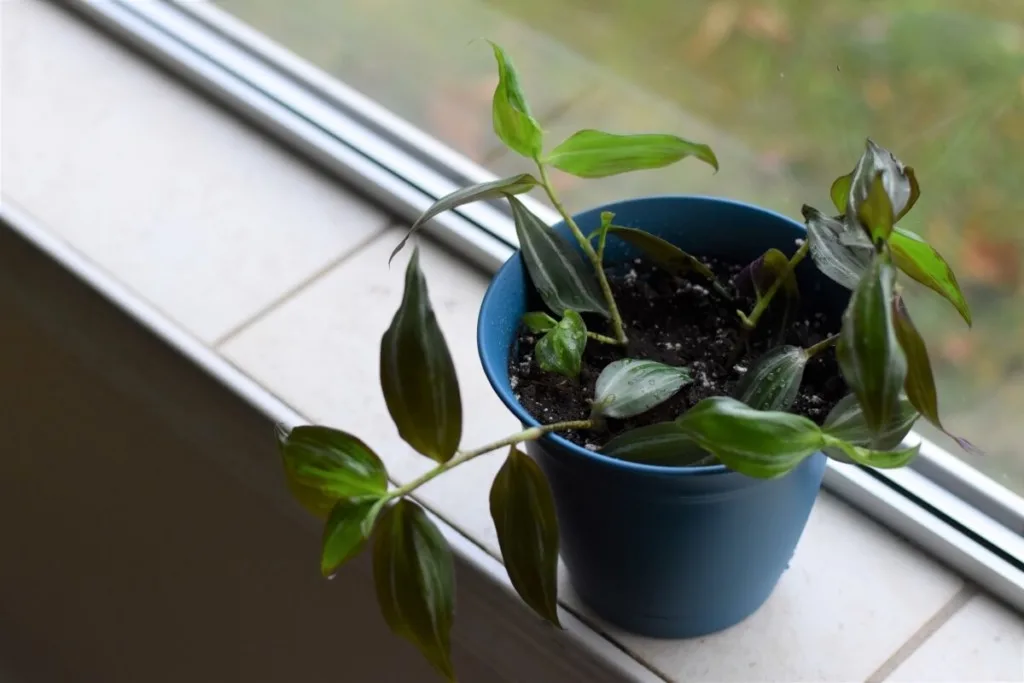
A testament to their hardiness –
One winter, when my hanging Inch Plant was looking especially scraggly, I pruned it back and repotted it. I kept some of the cuttings to propagate, but I tossed several leggy handfuls out my backdoor just to be rid of them. They landed in the snow and dirt behind some box elders.
And the darn things kept right on growing!
There they were, happy and healthy, next spring, so I pulled them up, repotted them, and brought them indoors.
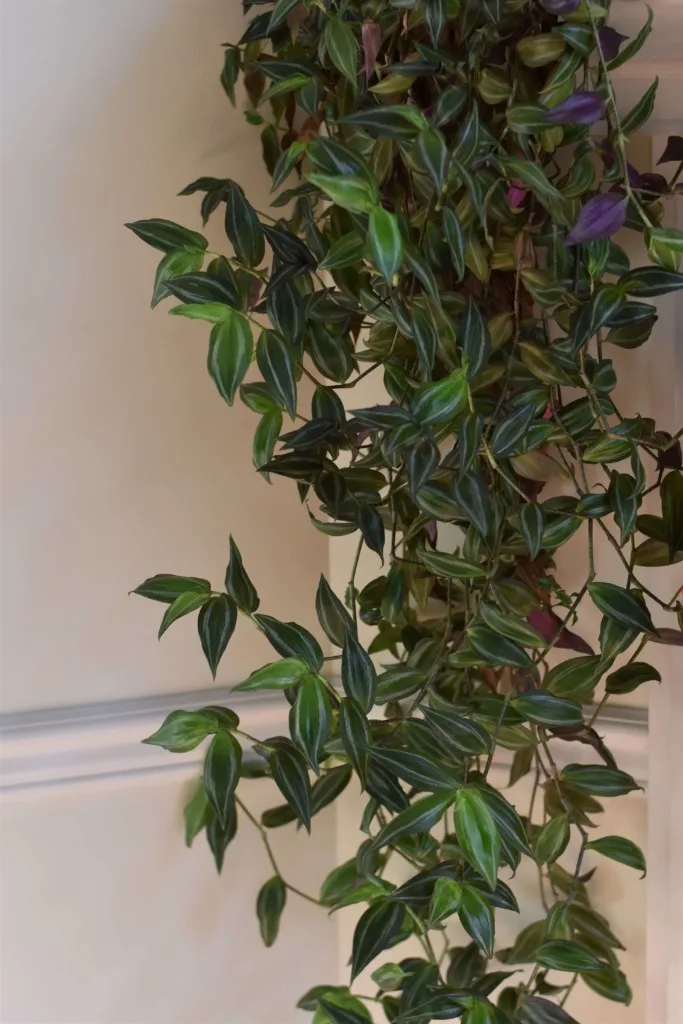
See what I mean? They’re nearly indestructible.
Pests and disease
Spraying frequently helps to keep one of the few pests that bother them at bay. Spider mites can sometimes be an issue for Inch Plants, simply rinse them off and mist the plant more frequently. Here’s how to quickly spot spider mites and eradicate them.
The Wandering Dude is susceptible to root rot. Again, you can prevent this by using a well-draining potting mix and not over-watering. You want the water to drain out of the bottom of the pot, not sit.
I like to put my Inch Plant in the shower once in a while and give it a quick rinse. This cleans the leaves of any dust, keeping them shiny and beautiful.
Propagating
If you should end up with root rot, pinch several stems off at the leaf node and start your plant over again. Tradescantia is ridiculously easy to propagate. Basically, any leaf node that is touching soil will begin to grow there.
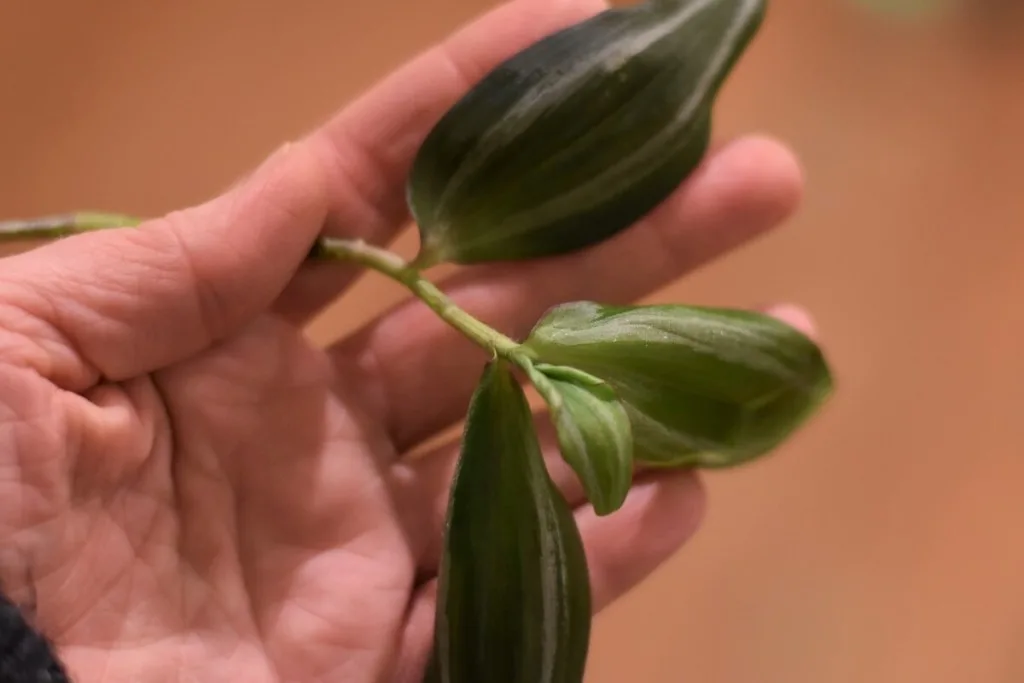
To start new plants, you’ll want to use leaders with new leaf growth and cut them just below a leaf node.
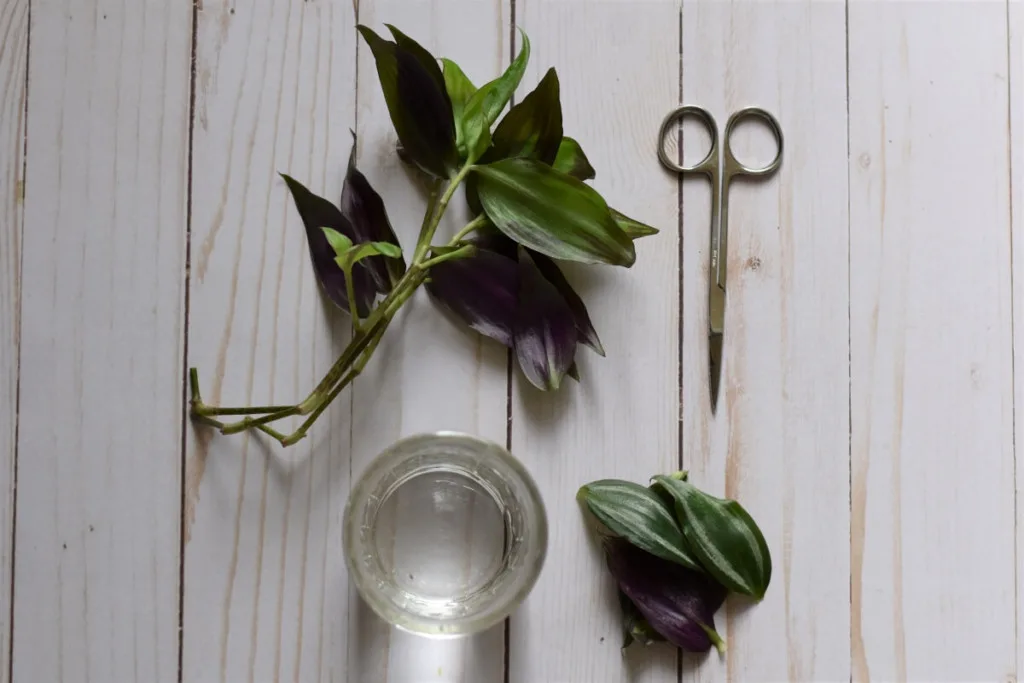
Each node has root cells and will begin to develop. Trim off the bottom few leaves, leaving a stem of around 2-4” to work with.
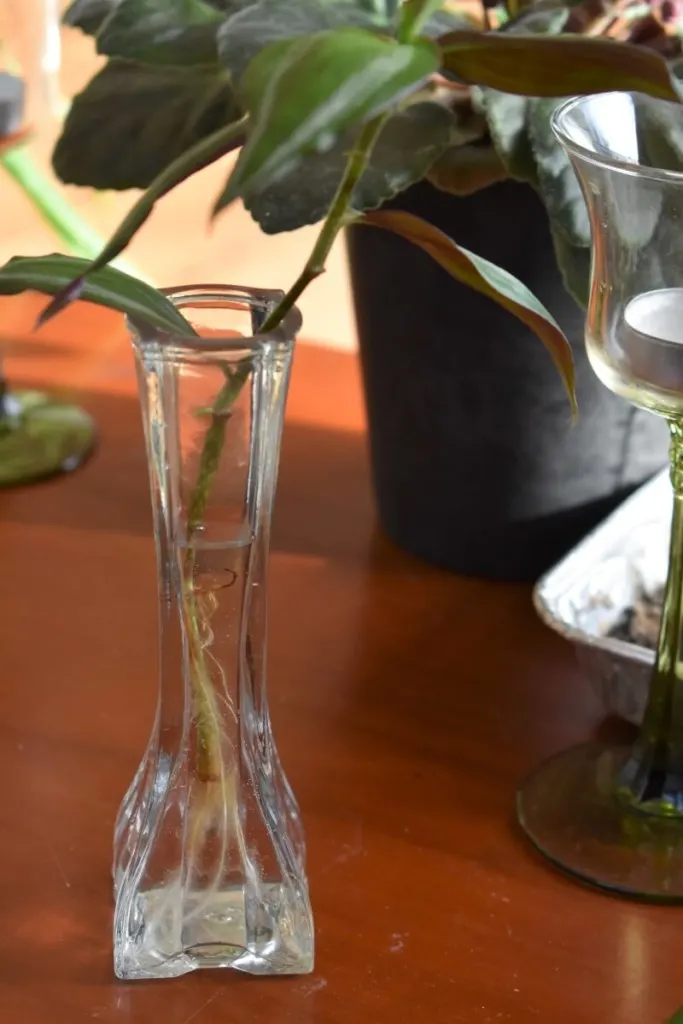
While you can start Wandering Dude in water, and I do, its susceptibility to root rot makes it a great candidate to propagate directly in the soil. Plant several of your trimmed stems in a pot, so you end up with a lovely bushy plant.
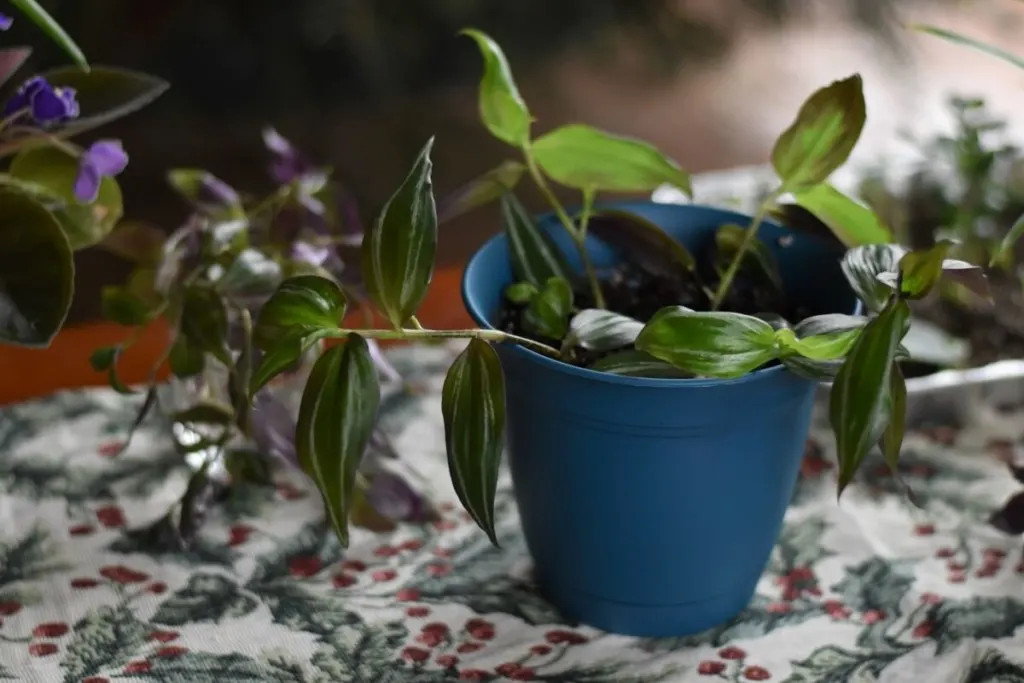
Pets
Inch Plant isn’t necessarily poisonous to cats and dogs, but if they ingest it, it will cause an upset stomach and can cause a skin reaction.
Some people also experience a rash from the plant’s sap (when the plant is cut open). It’s best to keep this plant up away from pets and small family members, just to be safe.
Where can I get a Wandering Dude?
If you would like to grow your own Wandering Dude, ask around. This plant lives up to its name and can be found just about everywhere. I’m sure someone you know can gladly provide you with a few plant cuttings.
If you can’t find it locally, I highly recommend Etsy for plant cuttings. It’s easy enough to filter your results to find plants in your location, making shipping easier. This is one houseplant that you will only ever have to purchase once.
I have killed many a houseplant over the years, but my Inch Plant is still around. I have shared cuttings with friends. I have pitched it in the snow. I have repotted it over and over again. I’ve even trimmed it back to stubs. And yet it still bounces back and looks better than ever.
So, I stand by my statement that it is the perfect houseplant. What do you think?



